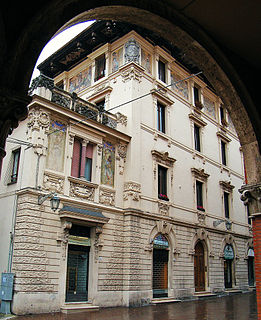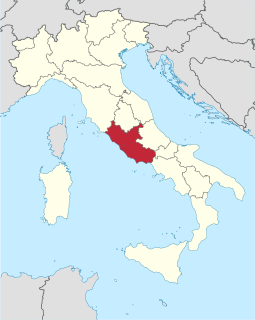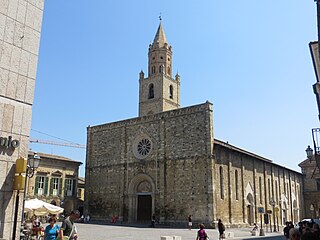Geography
It is located next to the small community of Ioanella and about 1.5 miles from Teramo, the provincial capital.

Teramo is a city and comune in the Italian region of Abruzzo, the capital of the province of Teramo.
The village of Villa Popola is divided into three small localities: Villa Torre (site of most of the residences), Popolo Alta and Popola Bassa. The last two locations are dominated by small, often economically impoverished, clusters of farmsteads.
Festivals
Each year, during the first part of June, the "Sagra del Formaggio Fritto" (Festival of Fried Cheese) takes place. In addition to a celebration of this famous dish, other delicacies and local wines are available for tasting. Exhibitions feature the transhumance (migrations of sheep and shepherds from lowland areas of Abruzzo and leading to higher grazing lands in Apulia, Lazio, and other parts of southern Italy). Various displays also depict the ancient professions of milling, cheese production, forestry, and woodworking.

Transhumance is a type of pastoralism or nomadism, a seasonal movement of livestock between fixed summer and winter pastures. In montane regions, it implies movement between higher pastures in summer and lower valleys in winter. Herders have a permanent home, typically in valleys. Generally only the herds travel, with a certain number of people necessary to tend them, while the main population stays at the base. In contrast, horizontal transhumance is more susceptible to being disrupted by climatic, economic, or political change.

Apulia is a region in Southern Italy bordering the Adriatic Sea to the east, the Ionian Sea to the southeast, and the Strait of Otranto and Gulf of Taranto to the south. The region comprises 19,345 square kilometers (7,469 sq mi), and its population is about four million.

Lazio is one of the 20 administrative regions of Italy. Situated in the central peninsular section of the country, it has almost 5.9 million inhabitants – making it the second most populated region of Italy – and its GDP of more than 170 billion euros per annum means that it has the nation's second largest regional economy. The capital of Lazio is Rome, which is also Italy's capital and the country's largest city.
This page is based on this
Wikipedia article Text is available under the
CC BY-SA 4.0 license; additional terms may apply.
Images, videos and audio are available under their respective licenses.

Frondarola is a small town in the province of Teramo in the Abruzzo region of Italy, population about 200. It lies at an altitude of 1502 feet above sea level and is located about 5 miles from Teramo, of which it is a frazione.
Nepezzano is a suburb (frazione) of the provincial capital Teramo, Italy and is located about 4 miles away from the town center.

Villa Vomano is a small village in the province of Teramo, in the Abruzzo region of central Italy. It is a frazione of the town of Teramo.

Montorio al Vomano is a town and comune in the province of Teramo, in the Abruzzo region of central-southern Italy. It is located in the natural park known as the Gran Sasso e Monti della Laga National Park.

Monticelli is a small village, a frazione of the comune of Teramo in the Abruzzo region of Italy. It has previously been called Monticulo and Monticello.

Scapriano is a small village in the province of Teramo, in the Abruzzo region of central Italy. It is a frazione of the town of Teramo.

Civitella Casanova is an Italian town of inland mountain of 1,950 inhabitants in the province of Pescara in Abruzzo and belongs to the mountain community Vestina. Listed on the National Park of Gran Sasso and Monti della Laga and the Regional Reserve Voltigno and Valle d'Angri, a regional reserve included in the National Park, the country bases its economy mainly on agriculture.
It has pre-Roman origins of repute, the sources of the historian Livy emerges as the town of Civitella was called Cutina or Cingilia.

Collevecchio is a small village in the Abruzzo region of Italy. It is a frazione of the comune of Montorio al Vomano.

Villa Ripa is a village in the province of Teramo, in the Abruzzo region of central Italy. It is a frazione of the comune of Teramo and has a population of about 700.

Magliano is a village in the Italian region of Abruzzo. It is a frazione of the comune of Torricella Sicura, in the Province of Teramo.
Spiano is a frazione of the commune of Teramo in the Abruzzo Region of Italy. It sits about seven miles from Teramo on a hill that overlooks both the Tordino and the Vomano valleys.
Ioanella is a frazione of the Commune of Torricella Sicura in the Province of Teramo, Italy
Colle Caruno is a frazione of the Commune of Teramo in the Abruzzo Region of Italy. It is located about four miles from the communal capital. In times past the village has been referred to in documents as Colacaruni or Collecaruni. These names likely derive from a certain Cola (Niccola) Caruni, buried in a graveyard in Teramo.
Villa Taraschi is a frazione in the Province of Teramo in the Abruzzo region of Italy.
Santa Margherita di Atri is a frazione in the municipality of Atri in the Province of Teramo in the Abruzzo region of Italy. It is located in the countryside and about 11 kilometers from the Adriatic Sea.

The traditional cuisine of Abruzzo is eclectic, drawing on pastoral, mountain and coastal cuisine. Staples of Abruzzo cuisine include bread, pasta, meat, cheese, and wine. The isolation which has characterized the region for decades has ensured the independence of its culinary tradition from those of nearby regions. Confesercenti, an Italian trade organization, conducted a 2013 study which called Abruzzo the best place to dine in Italy.

Atri Cathedral is a Romanesque Roman Catholic cathedral dedicated to the Assumption of the Virgin Mary in the town of Atri, Province of Teramo, region of Abruzzo, Italy.


















